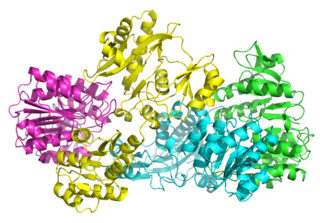| 2-(acetamidomethylene)succinate hydrolase | |||||||||
|---|---|---|---|---|---|---|---|---|---|
| Identifiers | |||||||||
| EC no. | 3.5.1.29 | ||||||||
| CAS no. | 37289-09-1 | ||||||||
| Databases | |||||||||
| IntEnz | IntEnz view | ||||||||
| BRENDA | BRENDA entry | ||||||||
| ExPASy | NiceZyme view | ||||||||
| KEGG | KEGG entry | ||||||||
| MetaCyc | metabolic pathway | ||||||||
| PRIAM | profile | ||||||||
| PDB structures | RCSB PDB PDBe PDBsum | ||||||||
| Gene Ontology | AmiGO / QuickGO | ||||||||
| |||||||||
In enzymology, a 2-(acetamidomethylene)succinate hydrolase (EC 3.5.1.29) is an enzyme that catalyzes the chemical reaction
- 2-(acetamidomethylene)succinate + 2 H2O acetate + succinate semialdehyde + NH3 + CO2
Thus, the two substrates of this enzyme are 2-(acetamidomethylene)succinate and H2O, whereas its 4 products are acetate, succinate semialdehyde, NH3, and CO2.
This enzyme belongs to the family of hydrolases, those acting on carbon-nitrogen bonds other than peptide bonds, specifically in linear amides. The systematic name of this enzyme class is 2-(acetamidomethylene)succinate amidohydrolase (deaminating, decarboxylating). This enzyme is also called alpha-(N-acetylaminomethylene)succinic acid hydrolase. This enzyme participates in vitamin B6 metabolism.




